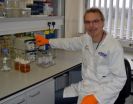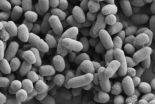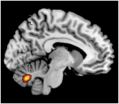(Press-News.org) Communication is vital to any successful relationship. Researchers from the Institute of Food Research and the University of East Anglia have discovered how the beneficial bacteria in our guts communicate with our own cells.
This is a key step in understanding how our bodies maintain a close relationship with the population of gut bacteria that plays crucial roles in maintaining our health, fighting infection and digesting our food.
A study, published in the journal Cell Reports, shows that the gut bacteria produce an enzyme that modifies signalling in cells lining the gut. The enzyme also has another role in breaking down food components.
"Our study provides a breakthrough in understanding how bacteria communicate across different kingdoms to influence our own cells' behaviour, as well as how we digest our food," said Dr Regis Stentz from the IFR, which is strategically funded by the Biotechnology and Biological Sciences Research Council.
We all rely on trillions of bacteria in our gut to break down certain components of our diet. One example is phytate, the form phosphorus takes in cereals and vegetables. Broken down phytate is a source of vital nutrients, but in its undigested form it has detrimental properties. It binds to important minerals preventing them being taken up by the body, causing conditions like anaemia, especially in developing countries. Phytate also leads to excess phosphorus leaching into the soil from farm animal waste, and feed supplements are used to minimise this.
But despite the importance of phytate, we know very little about how it is broken down in our gut.
To address this Dr Stentz and colleagues screened the genomes of hundreds of different species of gut bacteria. They found, in one of the most prominent gut bacteria species, an enzyme able to break down phytate. In collaboration with Norwich Research Park colleagues at the University of East Anglia, they crystallised this enzyme and solved its 3D structure. They then went on to characterise the enzyme, showing it was highly effective at processing phytate into the nutrients the body needs.
The bacteria package the enzyme in small 'cages', called outer membrane vesicles (OMVs) which allow phytate in for nutrient processing but prevent it being destroyed by our own protein-degrading enzymes. This releases nutrients, specifically phosphates and inositol, which can be absorbed by our own bodies, as well as the bacteria.
Working with Professor Stephen Shears, an expert in phosphate signalling from the US National Institutes of Health, the researchers showed that the OMVs containing the enzyme affect calcium signalling of colonic epithelial cells. Cells use calcium signalling to regulate different internal activities. This suggests that bacteria are using OMV-packaged enzymes to communicate directly with our cells and influence their behaviour, an example of cross-kingdom communication. OMVs have been observed from pathogenic bacteria looking to invade host cells, but this is the first example that benefits both the host and the bacteria.
"The enzyme we've uncovered has dual roles, in providing dietary nutrients as well as in modifying host cell behaviour," said Professor Simon Carding who leads IFR's research into gut health. "This opens up a number of very exciting areas of research."
Uncovering how we breakdown phytate will improve our understanding of how we maintain health, and possibly provide new avenues to reducing its effects in exacerbating malnutrition.
The researchers are interested in seeing how well this new enzyme compares with current fungus-derived feed supplements in preventing the problem of excess phosphorus from farm animal waste.
Co-author Dr Charles Brearley, from UEA's school of Biological Sciences, said: "The addition of enzymes, including phytases, to animal feed is a $725 million global industry. Industrial biotechnology, including the processes by which enzymes such as phytases are engineered, is a priority of the BBSRC."
"Our ongoing research here at UEA looks at the 3D structure of this novel phytase and the detailed analysis of phytate degradation. We believe this will be of great value in helping develop tomorrow's high value animal feed enzymes."
The IFR team also want to investigate the role these bacterial enzymes play in cross-kingdom communication, to find out the consequences of the calcium signalling changes. The gut lining is highly dynamic, containing stem cells that give rise to a number of different cell types that help to maintain the gut in a healthy state. Gut bacteria play a role in maintaining this healthy state, with diversions from this implicated in a number of diseases. Knowing how bacteria communicate with us opens up new possibilities to investigate this further.
"This has been a great example of how the Norwich Research Park's multidisciplinary research has cracked one of the big mysteries in gut health – how do beneficial bacteria communicate with human cells. " commented IFR's Professor Carding, who is also Professor of Mucosal Immunity at UEA. "We are attracting world leaders in this area to come and work with us, which is a real endorsement of our combined expertise."
INFORMATION:
This research was funded by BBSRC and the Intramural Research Program of the National Institutes of Health and National Institute of Environmental Health Sciences.
How bacteria communicate with us to build a special relationship
2014-02-13
ELSE PRESS RELEASES FROM THIS DATE:
Broad, MIT researchers reveal structure of key CRISPR complex
2014-02-13
Researchers from the Broad Institute and MIT have teamed up with colleagues from the University of Tokyo to form the first high definition picture of the Cas9 complex – a key part of the CRISPR-Cas system used by scientists as a genome-editing tool to silence genes and probe the biology of cells. Their findings, which are reported this week in Cell, are expected to help researchers refine and further engineer the tool to accelerate genomic research and bring the technology closer to use in the treatment of human genetic disease.
First discovered in bacteria in 1987, CRISPRs ...
Treating stroke with IV magnesium within an hour of symptoms fails to improve outcomes
2014-02-13
In the first study of its kind, a consortium led by UCLA physicians found that giving stroke patients intravenous magnesium within an hour of symptom onset does not improve stroke outcomes, according to research presented today at the American Stroke Association's International Stroke Conference.
However, the eight-year study found that, by working with paramedics in the field, intravenous medications can be given to stroke patients within the "golden hour," the window in which patients have the best chance to survive and avoid debilitating, long-term neurological damage. ...
Vitamin B12 accelerates worm development
2014-02-13
WORCESTER, MA – Everyday our cells take in nutrients from food and convert them into the building blocks that make life possible. However, it has been challenging to pinpoint exactly how a single nutrient or vitamin changes gene expression and physiology. Scientists at the University of Massachusetts Medical School have developed a novel interspecies model system that allows these questions to be answered. In a study appearing in the journal Cell, UMMS researchers use this new approach to show how bacterially supplied vitamin B12 changes gene expression, development and ...
Data links quick fix
2014-02-13
Software that can fix 90 percent of broken links in the web of data, assuming the resources are still on the site's server, has been developed by researchers in Iran. The details are reported this month in the International Journal Web Engineering and Technology.
Everyone knows the frustration of following a link to an interesting web site only to discover the target page is no longer there and to be presented with an error page. However, more frustrating and with wider implications for science, healthcare, industry and other areas is when machines communicate and expect ...
UEF study: Metabolic syndrome is similar in different age groups
2014-02-13
Metabolic risk factors cluster similarly in children and adults, according to a study carried
out at the University of Eastern Finland. Furthermore, in adults, the clustering of these risk
factors increases the risk of premature death caused by type 2 diabetes, myocardial infarction
and cardiovascular diseases. The results indicate that lifestyle interventions aiming at the
prevention of type 2 diabetes and cardiovascular diseases should be invested in already in
childhood. The results of the study were recently published in Diabetologia.
Metabolic
syndrome ...
Muscle loss ups mortality and sepsis risk in liver transplant candidates
2014-02-13
Japanese researchers have determined that sarcopenia—a loss of skeletal muscle mass—increases risk of sepsis and mortality risk in patients undergoing live donor liver transplantation. Findings published in Liver Transplantation, a journal of the American Association for the Study of Liver Diseases and the International Liver Transplantation Society, suggest that post-transplant sepsis was reduced in candidates with sarcopenia who received early nutritional support with a feeding tube, known as enteral nutrition.
While sarcopenia, defined as loss of muscle connected ...
Stanford climate scientist to discuss state of climate science, coming risks
2014-02-13
WHO: Chris Field, professor of interdisciplinary environmental studies at Stanford University
and co-chair of the U.N. Intergovernmental Panel on Climate Change (IPCC) Fifth Assessment
Working Group II.
WHAT: The world is staring down the barrel of climate change that is
faster than at any time in the last 65 million years, says climate expert Chris Field. He will
speak on the topic.
WHEN: Friday, Feb. 14, 1:30 to 4:30 p.m. CST.
WHERE: American
Association for the Advancement of Science (AAAS) Annual Meeting, Hyatt Regency, Grand Ballroom
B, ...
Diabetes, epilepsy and asthma increase risk of self-harm
2014-02-13
New research quantifying the risk of admission to hospital for self-harm has identified a raised risk of self-harm among groups of patients with certain physical illnesses. While it is known that psychiatric illnesses are associated with a greatly elevated risk of self-harm, a moderately elevated risk was seen with common physical illnesses such as diabetes, epilepsy and asthma. The research, published today by the Journal of the Royal Society of Medicine, investigated the risk of self-harm comparing people with different psychiatric and physical disorders in England.
Other ...
A promising new approach for treating leukemia discovered
2014-02-13
A group of researchers at the Institute for Research in Immunology and Cancer (IRIC) of Université de Montréal discovered a promising new approach to treating leukemia by disarming a gene that is responsible for tumor progression. That gene, known as Brg1 is a key regulator of leukemia stem cells that are the root cause of the disease, resistance to treatment and relapse.
Julie Lessard, principal investigator and her colleagues at IRIC have spent the past four years studying that gene in collaboration with another research group at Stanford University in California. The ...
How memory and schizophrenia are connected
2014-02-13
Many psychiatric disorders are accompanied by memory deficits. Basel scientists have now identified a network of genes that controls fundamental properties of neurons and is important for human brain activity, memory and the development of schizophrenia. Their results have been published in the online edition of the US journal Neuron.
The ability to hold transitory information - e.g. memorizing a telephone number - is a fundamental function of the human brain. This so-called working memory enables us to understand the world that surrounds us. To keep the working ...



